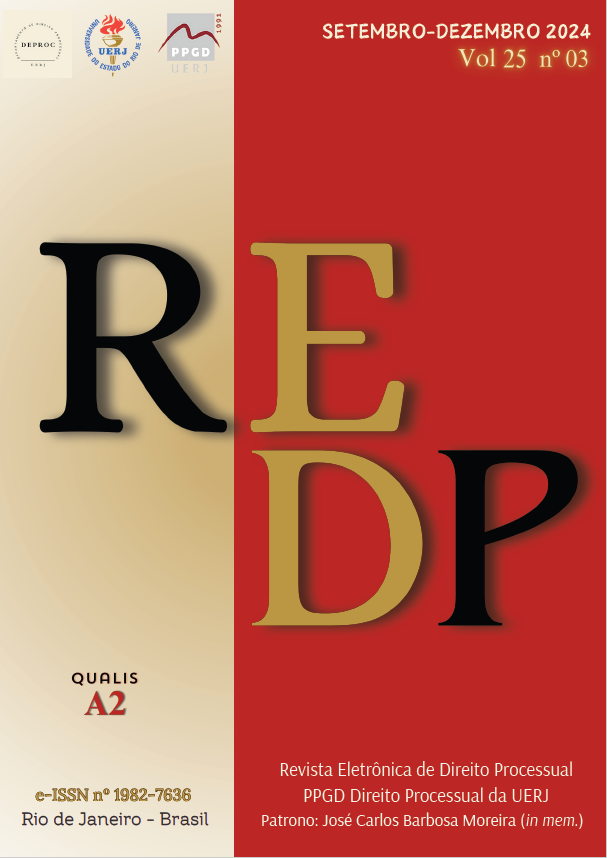DELIBERAÇÃO E VINCULAÇÃO: OS IMPACTOS DO MODELO DE JULGAMENTO DOS TRIBUNAIS BRASILEIROS SOBRE O SISTEMA DE PRONUNCIAMENTOS JUDICIAIS OBRIGATÓRIOS DO CPC/2015
DOI:
https://doi.org/10.12957/redp.2024.86630Resumo
O artigo discute os impactos do modelo deliberativo típico dos tribunais brasileiros sobre o sistema de precedentes ou pronunciamentos vinculantes adotado pelo Código de Processo Civil de 2015. O modelo vigente, com inspiração em países da Common Law onde predomina a tradição do stare decisis, contempla exigências específicas de fundamentação decisória. Nesta pesquisa, busca-se verificar se esses requisitos são compatíveis com a forma como as cortes do país deliberam e, sobretudo, como materializam por escrito as suas decisões. Na primeira seção, abordam-se os modelos deliberativos seriatim e per curiam, aberto e fechado, perseguindo o enquadramento do caso brasileiro dentro dessas classificações. A segunda parte destina-se à revisão das definições sobre a ratio decidendi ou os fundamentos determinantes de precedentes ou pronunciamentos vinculantes, ponto essencial na construção das decisões judiciais. Em seguida, a análise é aprofundada com a discussão sobre os reflexos dos modelos deliberativos para o sistema encampado pelo CPC. Por fim, propõe-se a continuidade do debate, para averiguar se há ou não um modelo ideal para o funcionamento daquele sistema. O artigo tem abordagem metodológica qualitativa, com revisão de literatura jurídica e doutrina, acrescida de constatações empíricas e análise de dados. Conclui-se que o modelo deliberativo típico dos tribunais brasileiros, aqui denominado como seriatim pro forma ou em estado potencial, aproxima-se do per curiam e atende melhor aos objetivos subjacentes à ideia de precedentes ou pronunciamentos vinculantes do que o seriatim clássico. Todos eles, porém, apresentam vantagens e desvantagens para o funcionamento do sistema.
Downloads
Publicado
Como Citar
Edição
Seção
Licença
Copyright (c) 2024 Tiago Cisneiros de Araújo, José Mário Gomes Neto

Este trabalho está licenciado sob uma licença Creative Commons Attribution 4.0 International License.
Todos os artigos publicados na Revista Eletrônica de Direito Processual (REDP) (Departamento de Direito Processual, Universidade do Estado do Rio de Janeiro, Brasil) são licenciados por meio de uma Licença Creative Commons - Atribuição 4.0 Internacional (CC BY 4.0).
Os autores retêm os direitos autorais de seu artigo e concordam em licenciar seu trabalho com a licença CC BY 4.0, aceitando assim os termos e condições específicos desta licença disponíveis no seguinte website: https://creativecommons.org/licenses/by/4.0/legalcode.
- Os autores concedem à REDP o direito de primeira publicação, de se identificar como publicadora original do trabalho e concedem à revista uma licença de direitos não exclusivos para utilizar o trabalho das seguintes formas: Reproduzir, vender e distribuir cópias eletrônicas ou impressas do manuscrito como um todo, de partes específicas do manuscrito e de suas traduções para qualquer idioma;
- O uso do artigo por terceiros é livre, contanto que a integridade da publicação seja mantida e seus autores originais, periódico de primeira publicação e detalhes de citação sejam identificados.
Dentro dos termos da licença, os autores podem entrar em acordos contratuais adicionais separados para a distribuição não exclusiva da versão publicada do trabalho na revista.
Copyright and Licensing
All articles published in the Procedural Law Electronic Review (REDP) (Department of Procedural Law, State University of Rio de Janeiro, Brazil) are licensed under a Creative Commons License - Attribution 4.0 International (CC BY 4.0).
- Authors retain copyright to their article and agree to license their work under the CC BY 4.0 license, thereby accepting the specific terms and conditions of this license available at the following website: https://creativecommons.org/licenses/by/4.0/ legal code.
- Authors grant REDP the right of first publication, to identify itself as the original publisher of the work, and grant the journal a non-exclusive license to use the work in the following ways: Reproduce, sell and distribute electronic or printed copies of the manuscript as a whole, of specific parts of the manuscript and its translations into any language;
- Use of the article by third parties is free, as long as the integrity of the publication is maintained and its original authors, first publication journal, and citation details are identified.
Within the terms of the license, authors may enter into separate additional contractual agreements for the non-exclusive distribution of the published version of the work in the journal.




